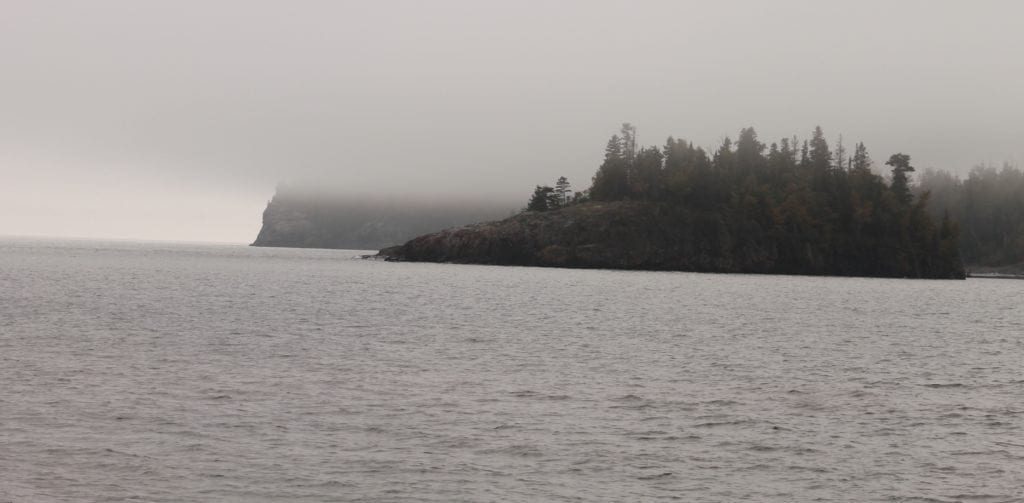I am on a mini vacation on the North Shore of Minnesota. Every year, I visit Lake Superior, one of the Great Lakes of the US. I love to look across this body of water and see not land, but the ongoing expanse of water to the horizon. This visit, the lake has been obstructed by fog. I can only see about 20 feet off the shore. I am feeling irritated by this disruption in my expectations.
Instead of holding on to my irritation, I shifted my thinking to wondering what lessons nature and fog can teach us. We are living in a time where seeing the horizon is less predictable. Disruptive technologies can collapse a business model of an organization, and turbulent external environments contribute to the number of wild cards that show up in our daily lives. A funding stream that was predictable is now uncertain or an environmental disaster can radically shift what consumers need and buy. Political events in one part of the world can impact the stock market in unpredictable ways as well. This is what interdependence does to our lives, it makes it more unpredictable and dynamic.

What Can Fog Teach Us About Disruption?
Fog is an interesting phenomenon. It is formed when there is a temperature difference between the ground and the air. We can experience fog when the temperature between the external environment is different than our organizations. This makes it difficult for our leaders to see what is happening.
Here are five lessons we can learn from fog that can help us live in a disruptive world:
1. Let Go of Expectations
The biggest lesson is to let go of the expectations and desire to see a clear horizon. This is harder than it seems. Part of our ability to adapt to disruption is connected to our ability to let go of what we expect, want, or need. These needs or wants are based in emotions. Our emotions are tough to release and when we continue to hold them, we get stuck and can’t adapt to the current reality. (see my blog on Accelerating Letting Go for more on this topic)
2. Practice Mindfulness
One of the reasons why our emotions make it difficult to move on is that we live in the past or the future. If we live in the past, we focus on how the present is different from, better, or worse than the past. This keeps our feelings front and center. If we are living in the future, we are focused on controlling the present to create the future we want. Worry and anxiety come from our past and future orientation. Mindfulness teaches us to be in the present. It is the place where worries or anxiety don’t exist. There is only the here and now. We relax into the present
3. Look for Lessons
When I posed the question What can I learn from fog? I shifted my orientation from feeling disappointed or frustrated by the fog to inquiry. Inquiry is a simple technique to shift focus into a different mental space. It helps us let go of the emotion and turns our attention to something that may lead to a more productive insight that we can act on.

4. Appreciate What is There
The fog has a beauty and mystery to it. Another technique to help us move through our emotions into the present is to actively appreciate what is. When confronted with a disruption, take time to appreciate what is happening. Noticing the beauty, mystery, or dynamic of it can help us release the emotions that are keeping us stuck.
5. Make Peace With the Unknown
I once visited the northern rim of the Grand Canyon. I was standing at the trailhead of Angle Bright Trail, which takes hikers from the rim to the floor of the canyon. As I was standing in the noise of traffic and visitors on the rim, I looked down towards the trail. I found that I lost sight of the trail about two switchbacks down. I decided to start walking down the trail. The first thing I noticed was the lack of noise. The second was that the trail kept unfolding as I travelled down the switchbacks. I still could only see about two switchbacks down the trail before it disappeared into the brush and shrubs, but if I continued walking the path became visible.
The Angle Bright Trail revealed itself as I moved down it. If I kayak onto the lake, the distance I can see into the fog remains about 20 feet. The lack of a clear visual makes measuring where you are compared to where you want to be difficult. The path to get there is more ambiguous and unknown. When we live in disruptive times, we need to learn to make peace with what is unknown.
Today, we have both knowns and unknowns. Interdependence and complexity increase the number of unknowns we face every day. Practicing these five simple strategies, can help us live with the unknown rather than mourn the loss of the known, and even enjoy the mysteries that the surprising disruptions are generating. After all, they can make our life fascinating.
Dr. Kathleen E. Allen writes a blog on leadership and organizations that describes a new paradigm of leadership that is based in lessons from nature and living systems. She is the author of Leading from the Roots: Nature Inspired Leadership Lessons for Today’s World (available for digital download June 5, 2018) and President of Allen and Associates, a consulting firm that specializes in leadership, innovation, and organizational change. You can sign up for her blog on her website: www.kathleenallen.net







This blog is one I need to revisit very often. Thank you.